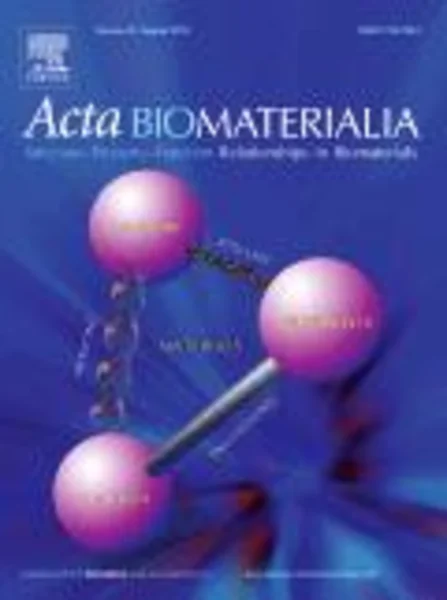-
persistence of a bioluminescent staphylococcus aureus strain on and around degradable and non-degradable surgical meshes in a murine model
جزئیات بیشتر مقاله- تاریخ ارائه: 1392/01/01
- تاریخ انتشار در تی پی بین: 1392/01/01
- تعداد بازدید: 846
- تعداد پرسش و پاسخ ها: 0
- شماره تماس دبیرخانه رویداد: -
biomaterials are increasingly used for the restoration of human function, but can become infected as a result of peri- or early post-operative bacterial contamination, although biomaterial-associated infections (bais) can also initiate at any time from hematogenous spreading of bacteria from an infection elsewhere in the body. infecting bacteria in bais not only seek shelter in their own protective biofilm matrix, but also hide in surrounding tissue. this study compares staphylococcal persistence on and around a degradable and non-degradable surgical mesh through the use of longitudinal bioluminescence imaging in a murine model, including histological evaluation of surrounding tissue after sacrifice. surgical meshes were first contaminated with bioluminescent staphylococcus aureus xen29 and subsequently subcutaneously implanted in mice. bioluminescent staphylococci persisted on and around non-degradable meshes during the 28-day course of the study, whereas bioluminescence returned to control levels and bacteria disappeared from surrounding tissues once a degradable mesh had fully dissolved. thus the application of degradable biomaterials yields major advantages with respect to the prevention of bais, as dissolution of the implant not only is associated with elimination of the protective biofilm mode of growth of the infecting organisms, but also allows the immune system to clear the surrounding tissue from infecting organisms.
مقالات جدیدترین رویدادها
-
استفاده از تحلیل اهمیت-عملکرد در ارائه الگوی مدیریت خلاقیت سازمانی و ارائه راهکار جهت بهبود
-
بررسی تاثیر ارزش وجوه نقد مازاد بر ساختار سرمایه شرکت های پذیرفته شده در بورس اوراق بهادار تهران
-
بررسی تأثیر سطح افشای ریسک بر قرارداد بدهی شرکت های پذیرفته شده در بورس اوراق بهادار تهران
-
بررسی تأثیر رتبه بندی اعتباری مبتنی بر مدل امتیاز بازار نوظهور بر نقد شوندگی سهام با تأکید بر خصوصی سازی شرکت ها
-
تأثیر آمیخته بازاریابی پوشاک ایرانی بر تصویر ذهنی مشتری پوشاک ایرانی (هاکوپیان)
-
ارزیابی کارایی ادارات تامین اجتماعی با استفاده از تکنیک تحلیل پوششی داده ها (مطالعه موردی استان سمنان)
-
مقایسه نتایج حاصل از تخمین تراوایی سازند با استفاده از شبکه های عصبی مصنوعی و روش آنالیز رگرسیونی
-
مقایسه تاثیرات ناشی از فعالیتهای انسانی(impact perception index) بر روی آبسنگهای مرجانی نای بند و عسلویه
-
بررسی عددی توزیع کرنش پلاستیک معادل، تنش پسماند و عمق نفوذ ساچمه در فرآیند شات پینینگ آلیاژ تیتانیوم گرید 5 با درصد پوشش دهی متفاوت بر مبنای مدل سلول متقارن
-
تاثیر نانوسیلیس بر خصوصیات بتن خودتراکم حاوی خاکستر بادی
مقالات جدیدترین ژورنال ها
-
مدیریت و بررسی افسردگی دانش آموزان دختر مقطع متوسطه دوم در دروان کرونا در شهرستان دزفول
-
مدیریت و بررسی خرد سیاسی در اندیشه ی فردوسی در ادب ایران
-
واکاوی و مدیریت توصیفی قلمدان(جاکلیدی)ضریح در موزه آستان قدس رضوی
-
بررسی تاثیر خلاقیت، دانش و انگیزه کارکنان بر پیشنهادات نوآورانه کارکنان ( مورد مطالعه: هتل های 3 و 4 ستاره استان کرمان)
-
بررسی تاثیر کیفیت سیستم های اطلاعاتی بر تصمیم گیری موفق در شرکتهای تولیدی استان اصفهان (مورد مطالعه: مدیران شرکتهای تولیدی استان اصفهان)
-
بایستگی التزام جامعه بین المللی به حق حاکمیت فلسطینیان بر اراضی اشغالی در سیاق حقوق بین الملل موضوعه
-
بررسی اثربخشی روان درمانی معنوی - مذهبی، بر کاهش استرس، اضطراب و افسردگی زنان دارای همسر معتاد شهر ایلام
-
تبیین فقهی احکام ولادت و آثار آن با محوریت نظرات آیت الله نجفی (صاحب جواهر)
-
شناسایی عوامل پیش برنده سازمانی در دست یابی به اهداف اقتصاد مقاومتی
-
بررسی تأثیر سرمایه اجتماعی بر چسبندگی هزینه: شواهدی از بورس اوراق بهادار تهران




سوال خود را در مورد این مقاله مطرح نمایید :